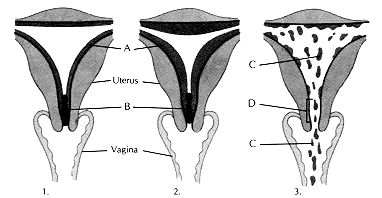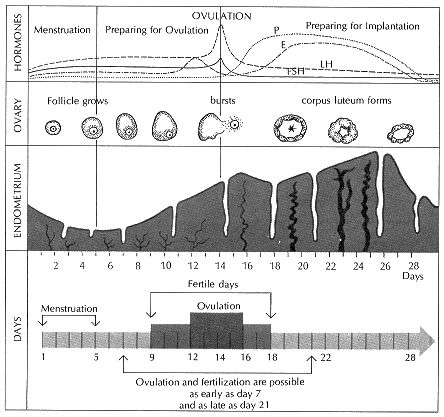|
|
||||||||||
|
|
2.2.3 THE MENSTRUAL CYCLE
I. THE THREE PHASES OF THE MENSTRUAL CYCLE (Seen as beginning after the last day of menstruation) 1. Preparing for Ovulation The endometrium begins to grow after menstruation. 2. Preparing for Implantation The endometrium is becoming ready for the implantation of a blastocyst. 3. Menstruation If no implantation occurs, the endometrium breaks down and is discharged in menstruation Key: A. Endometrium, B. Cervical mucus plug, C. Detached endometrium being discharged, D. Unplugged area, 1. Preparing for Ovulation When the menstrual flow comes to a halt, the uterine lining is very thin. However, it slowly begins to thicken under the influence of estrogen, a hormone that is produced by the ovaries and released into the bloodstream. The rising estrogen level also stimulates the growth of some of the Graafian follicles that encase the immature ova. Eventually, only one of these follicles completes its growth, while the others recede. After .approximately two weeks, one follicle, ruptures and releases the ovum. This release is known as ovulation. At the time of ovulation, the uterine lining has thickened considerably and is close to becoming ready for a possible implantation. An ovulation occurs about 14 days before the beginning of the next menstruation. That is to say, if the ovum is not fertilized and implanted, the uterine lining will break down and will be discharged two weeks later. Thus, counting backward, in a menstrual cycle of 28 days, ovulation occurs on the 14th day; in a cycle of 35 days, it occurs on the 21st day. In other words, while the time period between ovulation and next menstruation is relatively constant, that between menstruation and next ovulation can vary considerably. Couples who practice the rhythm method of contraception have to keep this fact well in mind. (See also "Contraception.") 2. Preparing for Implantation Shortly before ovulation, the follicle that encases the ovum begins to produce a new hormone called progesterone. This production increases dramatically after ovulation when the ruptured follicle is transformed into a "yellow body" (corpus luteum). In addition to progesterone, which plays an important part in the final preparation of the uterine lining, the yellow body also continues the production of estrogen. Under the influence of this hormonal stimulation, the lining of the uterus soon achieves its greatest thickness and receptivity for implantation. After its release from the ovary, the ovum enters the nearest Fallopian tube and begins traveling toward the uterus. Within a few hours, it undergoes its final maturation and becomes ready for fertilization. (For details, see "Conception.") After its fertilization, the ovum develops into a cell cluster which continues its journey through the Fallopian tube to the uterus, where it arrives about three days later. Finally, after another three to four days, it begins to implant in the nourishing uterine lining, thus starting pregnancy. A pregnancy helps to sustain the yellow body and its production of estrogen and progesterone. As a result, no new ovulation occurs, and the uterine lining does not deteriorate. In other words, in case of a pregnancy, the menstrual cycle is suspended at this point and does not enter the third phase described. 3. Menstruation A fertilization is possible only within the first 24 hours after ovulation. If the ovum does not encounter any sperm cells during this time, it simply dies and disintegrates. Obviously, in this case there is no implantation either. As a result, the thick special lining of the uterus is not needed, but soon begins to break down and slough off. The waste material, consisting mainly of mucus, lining tissue, and variable amounts of blood, is discharged through the vagina. This discharge is known as the monthly bleeding or menstruation (from Latin mensis, month). It usually lasts between 3 and 5 days. In popular language, these days are also sometimes referred to simply as the "period." The first day of menstruation is usually considered the first day of the entire menstrual cycle. During her "period" a woman may experience some physical discomfort, such as backaches, headaches, or cramps in the pelvic area. In fact, some women develop some of these symptoms a few days before the menstruation begins. Such premenstrual tension as well as menstrual discomfort can often be alleviated by medication. In any case, there is rarely a need for an interruption of regular daily activities. For example, a menstruating woman can participate in sports without impairing her health in any way. Most modern women wear tampons during their menstrual periods. These tampons are made of cotton or similar absorbent material, and they are introduced into the vagina where they absorb the menstrual flow. As long as they are replaced often enough, there is no medical objection to their use. In case of heavier menstrual bleeding, the traditional menstrual napkins may be more appropriate.
II. THE THREE PHASES OF THE MENSTRUAL CYCLE (Seen as beginning with the first day of menstruation) Key: FSH: the follicle-stimulating hormone; E: estrogen; LH: the luteinizing hormone; P: Progesterone. Note that the progesterone level rises considerably within twenty-four hours after ovulation. Sexual Intercourse During Menstruation In the past, many societies had strong prohibitions against sexual intercourse during menstruation. Generally, women were considered "unclean" during this time, and in some cultures there was a belief that sexual intercourse with a menstruating woman could make a man ill. However, modern medical research has exposed these and similar views as mere prejudices and superstitions. From a purely medical standpoint, there is no reason why sexual intercourse should not take place at any time during the menstrual cycle. In fact, many women are particularly responsive just before or during their periods. Still, some couples may hesitate to engage in coitus because of aesthetic objections to the bleeding, in this case, the use of a diaphragm should be considered. It will not only hold back the blood, but will also act as a means of contraception. After all, sperm cells can stay alive inside a woman's body for several days, and menstrual cycles can be quite irregular. An early ovutation can never be ruled out with complete certainty. {See also "Contraception.") Menopause Usually between the ages of 45 and 50 a woman will notice that her menstrual cycles become more and more irregular until, eventually, she ceases to menstruate altogether. This permanent cessation of menstruation is called menopause. A broader term, climacteric (Greek: critical period), refers to the general physiological and psychological changes that occur during this time in a woman's life. As described earlier, the number of a woman's oocytes dwindles to zero over the years. Correspondingly the woman also ceases to produce the hormones necessary for the preparation of the uterine lining. In some women, the resulting hormonal changes may, for a while, produce rather distressing symptoms, such as headaches, dizziness, fatigue, insomnia, and depression. Another symptom that may occur repeatedly is a "hot flash" or brief heat sensation spreading over the body. Such a flash may last from a second to a few minutes, and it may be followed by chills or heavy perspiration. These and other menopausal complaints can often be alleviated or even avoided by hormonal treatment. In most cases, the entire climacteric does not last longer than about two years. Although menstruations become increasingly rare during this period, ovulations (and therefore conceptions) are still possible. A woman who does not want to become pregnant during her climacteric is therefore well advised to continue the use of contraception. After one year without menstruation, however, she can safely assume that she is no longer fertile. The loss of fertility does not affect a woman's sexual responsiveness. In fact, many women show a renewed and increased interest in sexual intercourse once they can stop worrying about unwanted pregnancies. (See also "The Role of Hormones.") |


